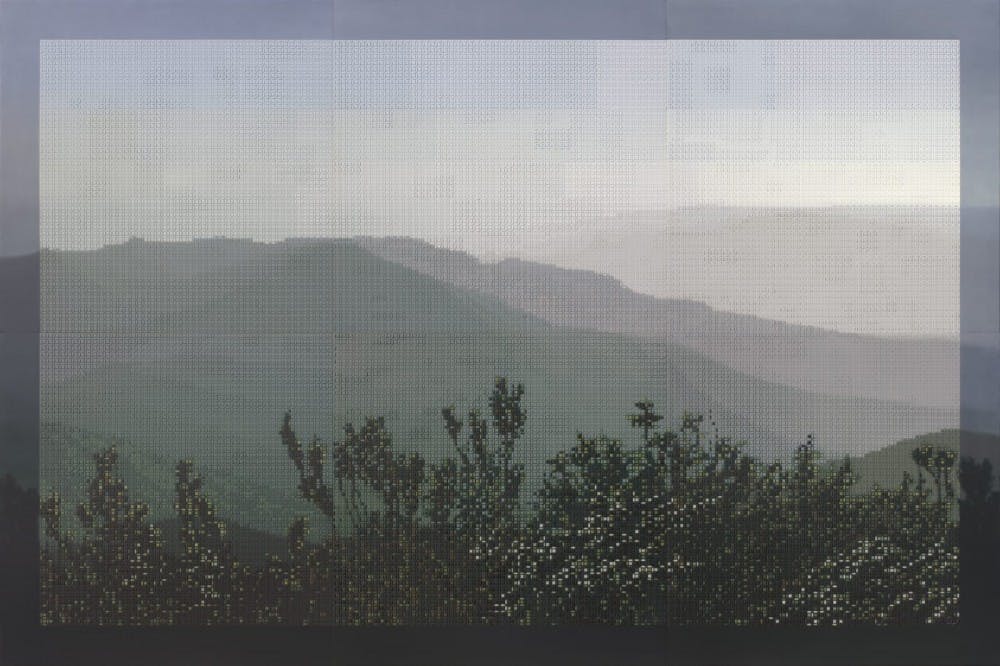There’s a small crowd of people spilling from the entrance of the Arthur Ross Gallery into the exhibit, curving out in both directions. A few minutes pass, and even more people slip in carrying small paper plates laden with foods like golden yucca sticks and squares of flan nestled in soup spoons.
The gallery is beautiful in its simplicity, spacious and brightly–lit. At this opening reception, all attention is directed at the man in the gray suit that almost complements the large painting of clouds he is standing in front of. This is Roger Toledo, the artist who brought the Soy Cuba exhibit to Penn this past Friday, April 5. The exhibit will continue through June 2.
Toledo talks about how each of the five paintings in the gallery were done using a stencil from Home Depot—which itself was also present at the exhibit. “[The stenciling] technique helps me to challenge myself,” Toledo said. Because of this, during the process he had to take into consideration both the dimension of the canvas and the dimension of the texture. Toledo concluded his overview of the project by inviting the audience to enjoy the refreshments, themselves, and the art. He was greeted by enthusiastic applause.

While some people waited to talk to him, many others took time to appreciate his paintings. Each took him around two months to complete and have multiple layers in order to reach a high level of detail. The exhibit features a total of five landscapes—clouds in the sky, a mountain range, a plain dotted with trees, a choppy seascape, and underwater views—that are significant and historical. The exhibit also contains the photographs that Toledo based his art off of, and translated quotes chosen by Penn Art History students that compliment Toledo's paintings. “Landscape doesn’t merely signify or symbolize power relations; it is an instrument of cultural power, perhaps even an agent of power…” reads one such quote by W.J.T. Mitchell, author of Landscape and Power.
These Art History students are from Professor Gwendolyn DuBois Shaw’s curatorial seminar; they also helped develop Toledo’s website and travelled to Havana to meet him last year.
On April 7, Professor Shaw made an appearance to give an introduction to Toledo’s lecture at the gallery. There, Toledo gave an overview of his background, both personal and artistic, and talked about “what it means to be an artist in Cuba.” He also presented a slideshow, depicting various pieces of his artwork over the years that finally led up to this exhibit.
Toledo was born in Cuba and attended two competitive art schools, Vicentina de la Torre Academy and the University for the Arts. He talked about how “he started to use painting as [his] language.” Later in his studies, the usage of squares became central to his art. This trend continued after he graduated from college—a few of his pieces are composed only of squares.
He then decided to experiment with landscapes, textures, and different ways to paint. It was around this time that he found templates, also from Home Depot, that he could use to create art. In the future, he hopes to make his own template designs.
Toledo will be hosting future events, including a color mixing program on Friday, April 12 from 11–11:50 a.m. (open to the public) and 12–1 p.m. (workshop with limited space—email Meg Pendoley at pendoley@upenn.edu if you want to register), a conversation with doctoral students Francesca Bolfo and Brett Robert about the exhibit on Friday April 26 from 1:30–2:30 p.m., and a 12–minute gallery talk on May 1 at 12 p.m.
If you’re interested in checking out the gallery, Soy Cuba / I Am Cuba: The Contemporary Landscapes of Roger Toledo will be open until June 2.







